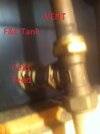thanks. none of our radiators have TVRs. I’ll look into this
Oh, how unusual, I am an electrician, I don't get evolved with plumbing, but sisters house back in around 1990 had TRV's and it seems odd to find a home without them.
The modern gas boiler is different to old gas and oil boilers in that is can extract the latent heat, to do this the return water must be cool, and to do this the boiler needs to modulate (turn down the flame height) so the TRV sets room temperature, and as it closes it causes first more water to flow though those still open and then for the by-pass valve to lift and as the hot water gets back to boiler the boiler auto turns down, once it can turn down no more the boiler starts to cycle off/on, however it can never turn off completely, so we fit a wall thermostat in a room normally kept cool, with no alternative heating, and no outside doors to turn off system when warm weather arrives, (if such a room exists).
This means the whole system should be controlled in the main by circulating water, only thing the thermostat does is turn it off in summer.
Oil and very old gas however work different, they have a thermostat in the main room, there is also a very modern system where the thermostat does not turn on/off but turns the boiler down, and connects to ebus, but not very common, Opentherm is such a system.
So the old system often had no run on system for boiler to cool, so the Y plan with a three port valve defaulted at DHW, so the boiler cools by heating the DHW rather than heat escaping through the flue, but the three port valves also had faults, main problem was the V3 micro switches sticking in, the complex internal wiring causes all sorts of odd things, but it was found when they stick by latching the valve into the bleed position with the manual lever often the central heating would continue to work of sorts.
However it resulted in summer the radiators would get warm when heating the DHW, may be worth checking if lever latched on.
I will admit as an electrician I was at first tricked by the Y Plan, as it seemed I was getting odd readings, and also found many incorrectly wired, missing DHW off wire from tank thermostat and programmer common, plus using earth wires for live. It seems I was not the only one who found the Y Plan hard to understand.
However if set up correctly it works well, but should not use a type AC RCD when using Y Plan, not that that will bother you.
My own house was such a mess when I moved in, had to go outside walk down a set of steps and plug in the central heating pump when turning it on, reverse turning off, and I still can't believe the previous owners put up with that, seems they used a wood burning fire. The oil heating engineer it seemed had no idea how to wire, due to having two pumps, lucky I did, but it seems in Mid Wales where I now live in the land of the blind the one eyed man is king, and there are a lot of so called tradesman who would not have lasted a couple of months in North Wales.
I did take a careful note of the sticker on the boiler saying call this number for service to ensure I never use them, as clearly they have even less a clue what they are doing, I suppose a plumber is a worker of lead, so does work from sealing roofs to tuning organs as well as pipe work, and with such a range one can excuse them not learning how to do electrics as well, even if we do use leaded solder.


